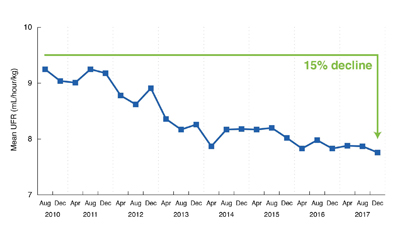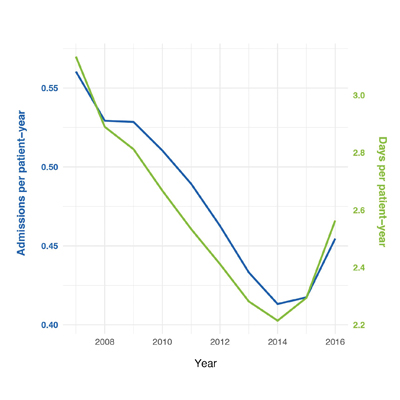Management of volume status during and between hemodialysis sessions
During the past decade, the clinical relevance of ultrafiltration intensity has come into greater focus. The ultrafiltration rate, measured in milliliters per hour and scaled by body weight, appears to be associated with an array of outcomes. In an early study, Flythe and colleagues1 re-analyzed data from the Hemodialysis Trial. Results showed that, relative to UFR less than 10 mL/hour/kg, UFR between 10 mL/hour/kg and 13 mL/hour/kg was not associated with risk of death, whereas UFR greater than 13 mL/hour/kg was associated with significantly higher risks of both all-cause and cardiovascular death. In subgroup analysis, even UFR between 10 mL/hour/kg and 13 mL/hour/kg was associated with higher risk of death among trial participants with heart failure.
In a subsequent analysis of more than 118,000 patients on hemodialysis in a large dialysis organization, UFR was associated with mortality in a graded fashion: relative to UFR less than 6 mL/hour/kg, UFR intervals of 6 mL/hour/kg to 8 mL/hour/kg, 8 mL/hour/kg to 10 mL/hour/kg, 10 mL/hour/kg to 12 mL/hour/kg, 12 mL/hour/kg to 14 mL/hour/kg and greater than 14 mL/hour/kg were associated with 3%, 9%, 15%, 23% and 43% higher risks of death, respectively. In a single-center study from France, Chazot and colleagues2 reported a similar nature of association: Each 1-mL/hour/kg increment was associated with a 15% higher risk of death, despite median treatment duration of 5 hours. Furthermore, UFR is associated with post-dialysis recovery time (ie, the response to “How long does it take you to recover from a dialysis session?”). Among almost 2,700 patients in a not-for-profit dialysis organization, UFR greater than 13 mL/hour/kg vs. less than 10 mL/hour/kg was associated with 28% higher odds of longer vs. shorter recovery time.

With these and other studies in hand, many leaders in U.S. nephrology have aimed to lower UFR among in-center hemodialysis patients. The collective effort has borne fruit, according to the DOPPS Practice Monitor.3 In December 2011, mean UFR was 9.2 mL/hour/kg. By December 2017, mean UFR was 7.8 mL/hour/kg (see Figure 1). Meanwhile, the percentage of patients with UFR greater than 13 mL/hour/kg fell from 16% to 9%. Of course, UFR can be lowered by limiting interdialytic weight gain or lengthening cumulative treatment duration each week. In an analysis of prevalent in-center patients on hemodialysis, Flythe and colleagues4 reported that both higher interdialytic weight gain and shorter treatment duration — the numerator and denominator of unscaled UFR, respectively — were associated with increased mortality. Thus, both interdialytic weight gain and treatment duration are plausible targets for quality improvement.
Process to lower UFR
How have we lowered mean UFR by roughly 15% in 6 years? It is difficult to attribute much of the decline to changes in cumulative treatment duration. In the facility setting, three sessions per week remains the dominant schedule. Furthermore, according to the United States Renal Data System (USRDS),5 the percentage of patients on home hemodialysis, in which higher treatment frequency is common, increased only from 1.65% in 2011 to 1.76% in 2016. Nevertheless, in the facility setting, mean treatment duration has increased slightly, from 217 minutes in December 2011 to 222 minutes in December 2017. Interdialytic weight gain is more difficult to assess. The DOPPS Practice Monitor3 reports intradialytic weight loss as a percentage of post-treatment weight. In December 2011, mean intradialytic weight loss was 3.2% of weight, compared to 2.7% in December 2017. As an aside, mean BMI has increased only modestly, according to the DOPPS Practice Monitor, from 28.1 kg/m2 in December 2011 to 28.6 kg/m2 in December 2017. Thus, although treatment duration and BMI have each applied modest downward pressure on UFR, the dominant force has been a decline in intradialytic weight loss.
Although intradialytic weight loss and interdialytic weight gain are closely related concepts, they are of course not identical. Intradialytic weight loss falls when the difference between pre-dialysis weight and dry weight shrinks. A difference has two parts. Therein lies the riddle. Has pre-dialysis weight declined—reflecting greater success at limiting fluid intake between consecutive treatments—or has target weight increased, essentially leaving patients “wetter” during interdialytic gaps?

To answer this question, we can examine a few clinical outcomes. Pre-dialysis systolic blood pressure (SBP) is one outcome. Among the April, August and December 2011 samples in the DOPPS Practice Monitor, mean pre-dialysis SBP was 147.2 mmHg. Among corresponding samples in 2017, mean pre-dialysis SBP was 146.7 mmHg. That difference is a modest one and hardly suggests a significant change in fluid load during the interdialytic interval.
Perhaps more interesting is hospitalization. The USRDS recently released a new Annual Data Report5 which includes rates of hospitalization through 2016. Between 2007 and 2014, the adjusted rate of cardiovascular hospitalization in patients on hemodialysis fell steadily. But the rate has subsequently inched upward (see Figure 2). Correspondingly, the adjusted number of hospitalized days due to cardiovascular morbidity has increased. This bump has occurred in tandem with steadily increasing rates of emergency department visits and observation unit stays.
Of course, claims data have numerous limitations. There are holes in every analysis. In this case, 2015 was punctuated by a big event: the October 1 transition from ICD-9 to ICD-10 diagnosis and procedure codes. It remains unclear even now whether the transition to ICD-10 led to an artificial increase in cardiovascular morbidity -related diagnosis coding during hospitalization. Nevertheless, even if we are skeptical about the bump in cardiovascular hospitalization and instead suppose that the cardiovascular hospitalization rate is fixed, the question remains: Why has a 15% decrease in the population UFR not led to clear improvements in clinical outcomes? It seems plausible that gains due to lower UFR have been cancelled by losses due to higher interdialytic fluid load.
At the ASN Kidney Week in 2018, Silberzweig and colleagues6 shared worrisome data. The research team assessed the effects of requiring that UFR be less than 13 mL/hour/kg. Across the seven facilities operated by the Rogosin Institute, 90% of nearly 1,200 patients maintained UFR below 13 mL/hour/kg. However, 4% of patients during a 3-month period were hospitalized for symptoms related to fluid overload; 25% had inadequate blood pressure control; and 22% required more than three antihypertensive agents to control blood pressure.
Ultimately, the UFR exposes an inherent problem with thrice-weekly in-center hemodialysis in the United States: At present, the average patient receives slightly more than 11 hours for cumulative ultrafiltration per week. If we lower UFR, but leave treatment duration alone, we must remove less fluid per hour — hopefully, only because we need to remove less fluid per hour. The alternative approach is to add treatment hours. Doing so in the facility setting is not easy. In-center nocturnal hemodialysis is an option in some markets. Frequent diurnal or nocturnal hemodialysis in the home setting is an option in nearly all markets. Regardless of setting, we must always recognize that fluid dynamics are both an intradialytic issue and an interdialytic one. Consider this: Assimon and colleagues7 reported that the adjusted hazard ratio of death for UFR greater than vs. less than 10 mL/hour/kg is 1.22, whereas Zoccali and colleagues8 reported that the adjusted hazard ratios of death associated with chronic fluid overload ranged from 1.51 to 1.94, depending on concurrent blood pressure. Furthermore, Movilli and colleagues9 showed in a small study from Italy that each 1-kg increment in the difference between actual and target post-dialysis weight was associated with 2.7-times higher risk of death. From the perspective of numbers alone, primarily focusing on minimizing interdialytic fluid load, instead of UFR, this looks like the rational approach.

Conclusion
Admittedly, most of this discussion is a hypothesis. It seems clear that population UFR has decreased, but the ongoing evolution of clinical outcomes is murky. It is difficult to find evidence of recent improvements in mortality and hospitalization. There is a pressing need to identify whether increased scrutiny of UFR has led to unintended consequences. If we have simply increased dry weight by 1 kg or 2 kg to achieve a UFR target, but now more frequently observe symptoms of fluid overload, elevated blood pressure, and complications necessitating acute care, then we have won a battle, but lost the war. The hard reality is winning the war on fluid will require more treatment hours per center than are currently delivered.
- For more information:
- Eric D. Weinhandl, PhD, MS, is a clinical epidemiologist and biostatistician for NxStage Medical in Lawrence, Massachusetts.
- References:
- 1. Flythe JE, et al. Kidney Int. 2011; doi:10.1038/ki.2010.383.
- 2. Chazot C, et al. Blood Purification. 2017; doi:10.1159/000464346.
- 3. DOPPS Practice Monitor. www.dopps.org/DPM/Files/UFR2mlkghr_overallTAB.htm. Accessed 28 Jan 2018.
- 4. Flythe JE, et al. CJASN. 2013;doi:10.2215/CJN.09460912.
- 5. USRDS. 2018 USRDS Annual Data Report.
- 6. United States Renal Data System, 2018 Annual Data Report, Vol. 2. Data from Fig. 4.2 and 4.6.
- 7. Assimon MM, et al. AJKD. 2016; doi:10.1053/j.ajkd.2016.06.020.
- 8. Zoccali C, et al. JASN. 2017;doi:10.1681/ASN.2016121341.
- 9. Movilli E et al. Am J Neph. 2013; doi:10.1159/000349931.
Disclosure: Weinhandl reports no relevant financial disclosures.
